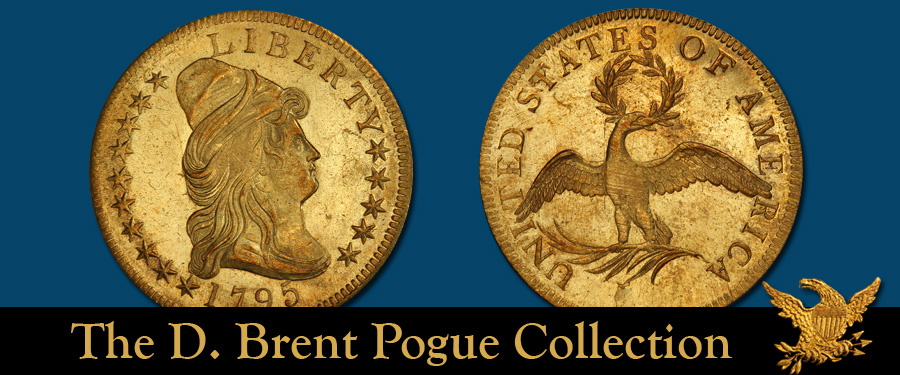
D. Brent Pogue Collection Part 2 Update
As you read these words we are immersed in creating the catalog for Part II of the most valuable collection ever to cross the auction block. The venue will be the gallery of Sotheby’s in New York City, and the date is September 30. We invite you to participate as a bidder or as an observer in an event that will forever echo in the halls of numismatics.
In the meantime you will enjoy reading the two great books we have published:
Treasures from the D. Brent Pogue Rare Coin Cabinet, 208 pages, color illustrated, quality hardbound. This tells the stories of 100 special coins in the copper, silver and gold series, selected from over 650 specimens to be auctioned. We guarantee you several evenings of enjoyable reading. $39.95 plus shipping.
The 1822 Gold Half Eagle: Story of a Rarity, 128 pages, color illustrated, quality hardbound. The Pogue Collection 1822 half eagle, the only one in private hands, provides the opportunity to discuss the three pieces in existence (the other two are in the National Numismatic Collection), their owners over a long period of time, and the story of coin collecting from the 19th century to modern times. $39.95 plus shipping.
For more information or to order visit http://media.stacksbowers.com/poguecollection/pogue-the-books.html
The Famous 1795 Eagle with 9 Leaves in the Branch
Ranking high in the pantheon of American gold coin rarities is the 1795 $10 gold coin with just 9 leaves in the palm branch instead of the usual 13. The Pogue specimen of Bass Dannreuther-3 is an incredible MS-63+ (PCGS), in a three-way tie with two others. No finer coin has been seen by this grading service.
We estimate that only three to five true Mint State examples of this variety exist, plus seven to 10 that show signs of circulation, usually light. Even an EF or AU coin would be a memorable addition to a great collection.
In July 1989 Superior Galleries offered this coin, emphasizing its unusually fine quality:
A few minor adjustment marks on the eagle. Vivid yellow gold luster with glowing prooflike reflectiveness, this coin features what every numismatist admires in top quality early American gold rarities: originality and freshness, and, of course, rarity. By originality we mean crisp luster which has never seen a brush or wiping rag and whose mint bloom is as sparkling as the day the coin popped from the dies. Freshness, as this one epitomizes, belongs to those which have not seen the light of days for many long years, ones whose origin may be shrouded in the anonymous fog of time.
As to rarity, this is what this elegant 1795 eagle is all about. It is the rarest major variety in the entire series, a series that spans more than a century and a quarter… Numismatists have found only seven distinct specimens of which this is by far the most spectacular… If you are a collector who wants to own an ‘ultimate’ coin (and who doesn’t), a coin that towers head and shoulders above its competition, then here it is.
Of this variety, David W. Akers commented in his book on the $10 denomination:
A number of varieties of 1795 are known and one is worth special mention. It is the variety with nine leaves (rather than 13) on the branch under the eagle. This nine leaves variety is a major rarity (in my opinion the rarest of all eagles) and probably less than 10 specimens are known. It has never received any publicity…only because cataloguers have seldom indicated the number of leaves on the particular coin being catalogued.
Our congratulations in advance to the successful bidder for the rarest major variety in the early eagle series.





